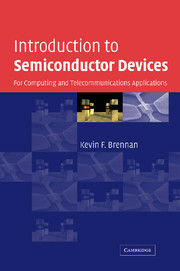Book contents
- Frontmatter
- Contents
- Preface
- List of physical constants
- List of materials parameters for important semiconductors, Si and GaAs
- 1 Semiconductor fundamentals
- 2 Carrier action
- 3 Junctions
- 4 Bipolar junction transistors
- 5 JFETs and MESFETs
- 6 Metal–insulator–semiconductor structures and MOSFETS
- 7 Short-channel effects and challenges to CMOS
- 8 Beyond CMOS
- 9 Telecommunications systems–an overview
- 10 Optoelectronic devices – emitters, light amplifiers, and detectors
- 11 Transistors for high frequency, high power amplifiers for wireless systems
- References
- Index
11 - Transistors for high frequency, high power amplifiers for wireless systems
Published online by Cambridge University Press: 05 June 2012
- Frontmatter
- Contents
- Preface
- List of physical constants
- List of materials parameters for important semiconductors, Si and GaAs
- 1 Semiconductor fundamentals
- 2 Carrier action
- 3 Junctions
- 4 Bipolar junction transistors
- 5 JFETs and MESFETs
- 6 Metal–insulator–semiconductor structures and MOSFETS
- 7 Short-channel effects and challenges to CMOS
- 8 Beyond CMOS
- 9 Telecommunications systems–an overview
- 10 Optoelectronic devices – emitters, light amplifiers, and detectors
- 11 Transistors for high frequency, high power amplifiers for wireless systems
- References
- Index
Summary
Solid state devices and their associated circuits used in wireless systems operate from the ultra-high frequency (UHF) to millimeter-wave frequencies. Each system requires various RF functionalities such as switching, amplification, mixing, filtering, sampling, dividing, and combining. Some of these functions are produced using a mixture of active and passive components. The active components are typically transistors, primarily FETs and BJTs.
The power amplifier is the critical portion of the RF front end in a wireless telecommunications system. The two most prevalent applications of power amplifiers in wireless systems are in cellular telephones and base stations. Power amplifier performance depends to some extent on some or all of the following: power, gain, efficiency, linearity, reliability, and thermal management issues. Any one of these specifications can be traded off against any other one. Additionally, none of these issues is solely dependent upon the device itself. For example, reliability and thermal management depend upon packaging and bonding in addition to their dependence on the circuit elements. The performance attributes are also coupled. The higher the device output power the more important thermal management becomes. Thus optimization for one parameter often impacts another device parameter that in turn may require different optimization. In the first part of this chapter we will discuss some of the performance metrics and examine how they vary with device type and design when used in power amplifiers. In addition to providing high power, the frequency of operation of a power transistor used in wireless systems must be high. Therefore, transistors must be optimized to deliver high output power at high frequency.
- Type
- Chapter
- Information
- Introduction to Semiconductor DevicesFor Computing and Telecommunications Applications, pp. 275 - 299Publisher: Cambridge University PressPrint publication year: 2005



